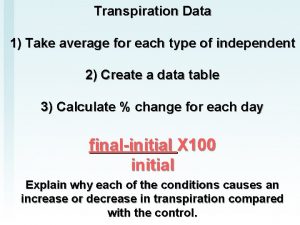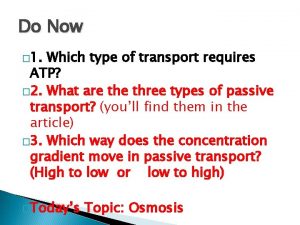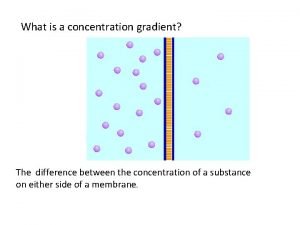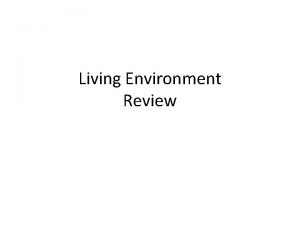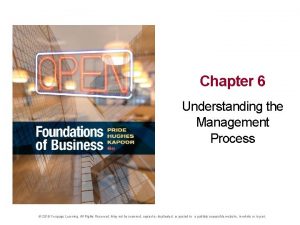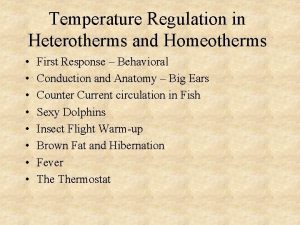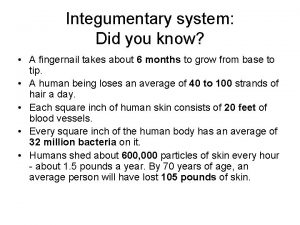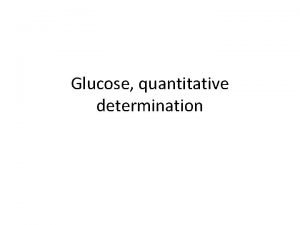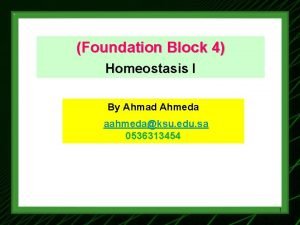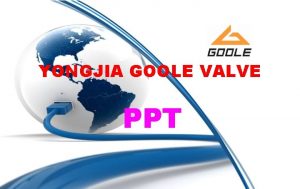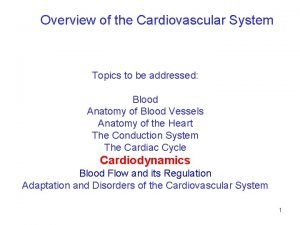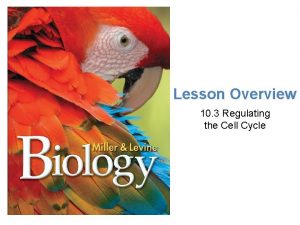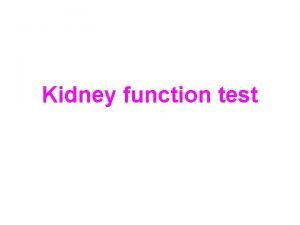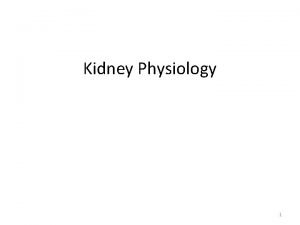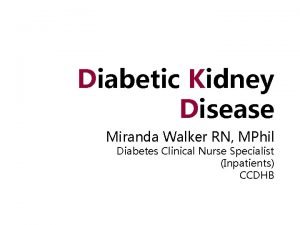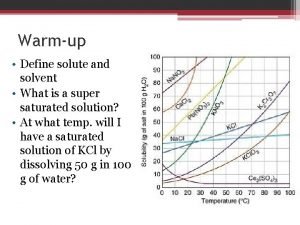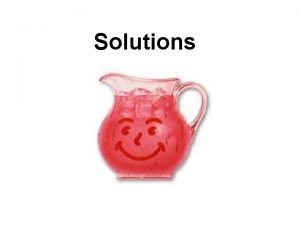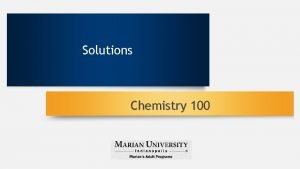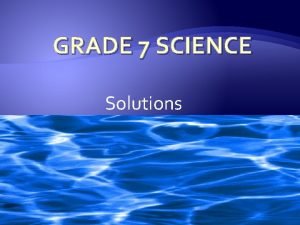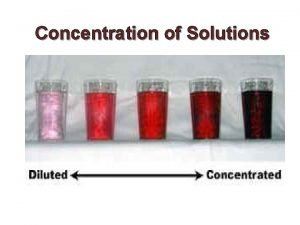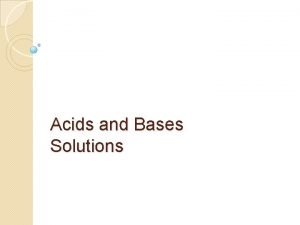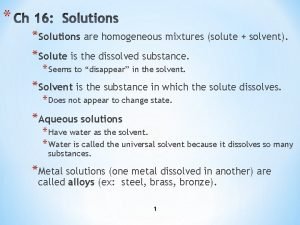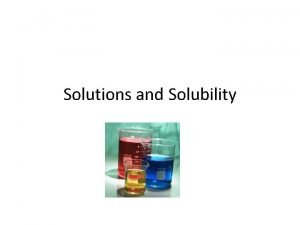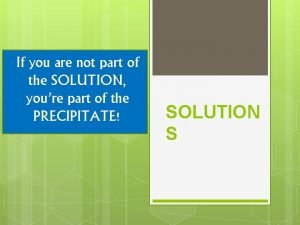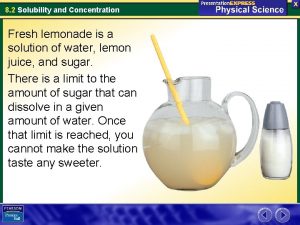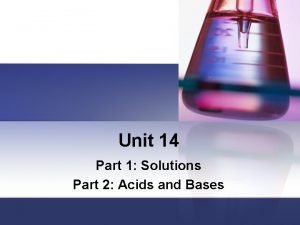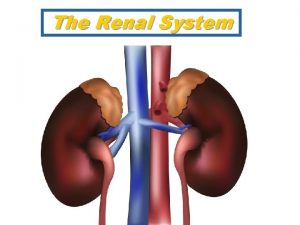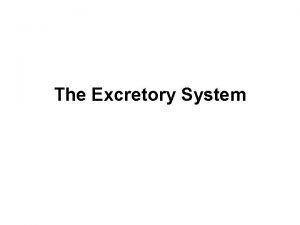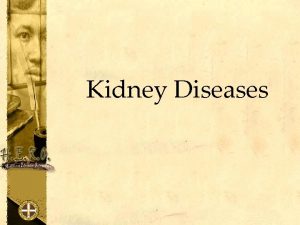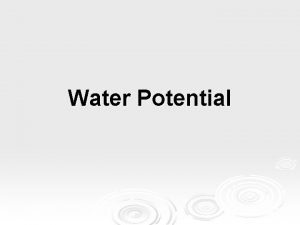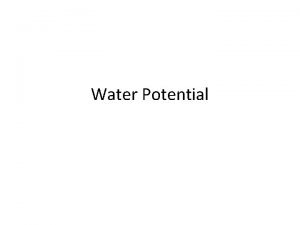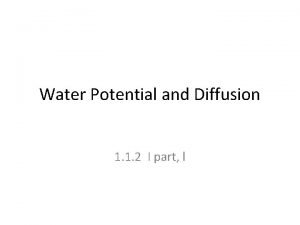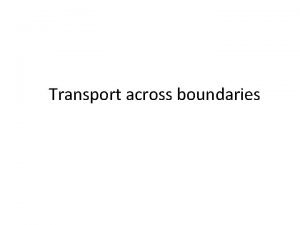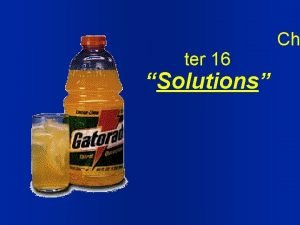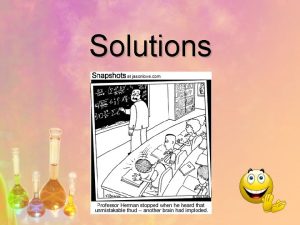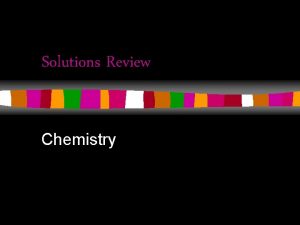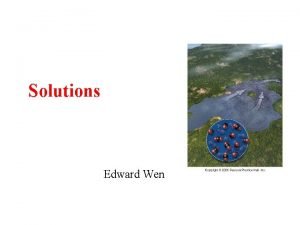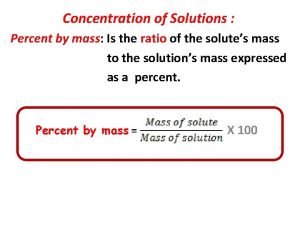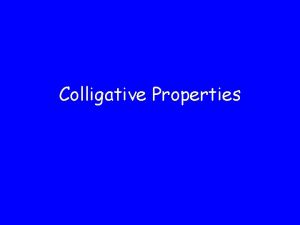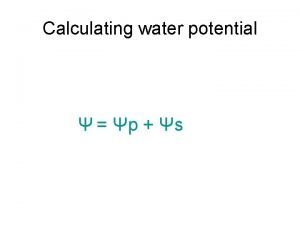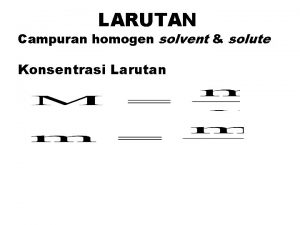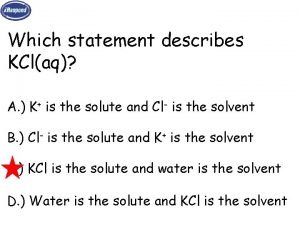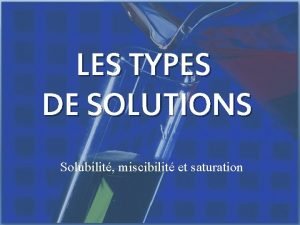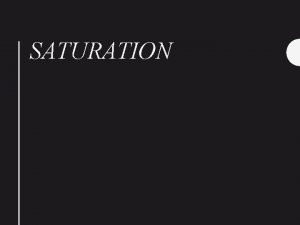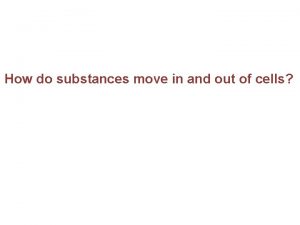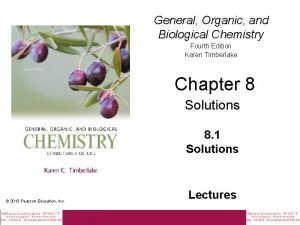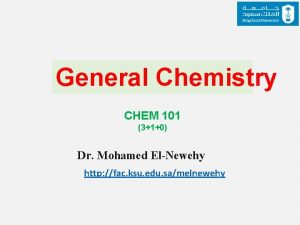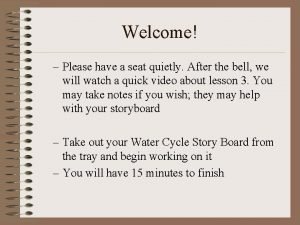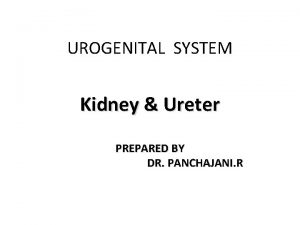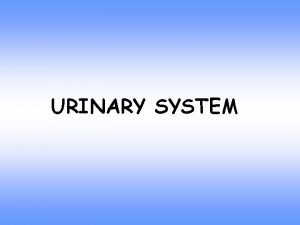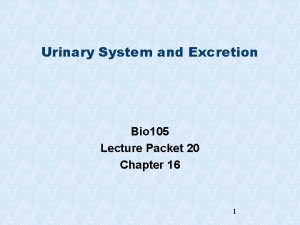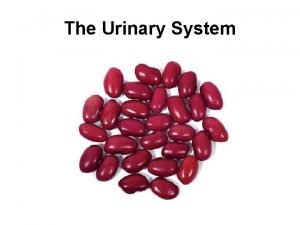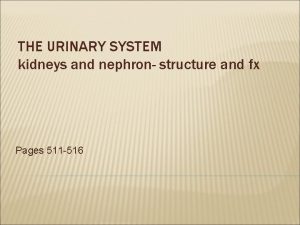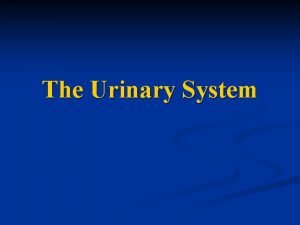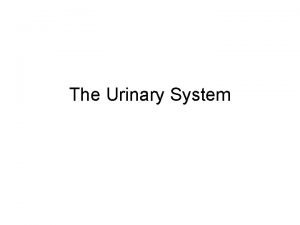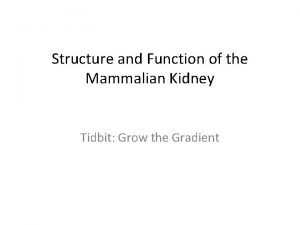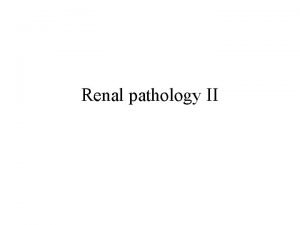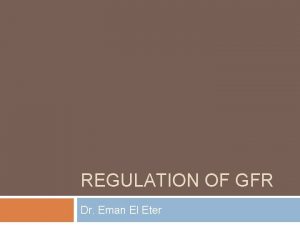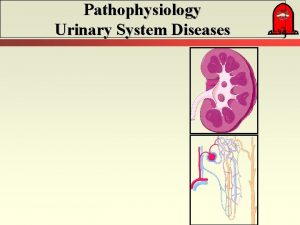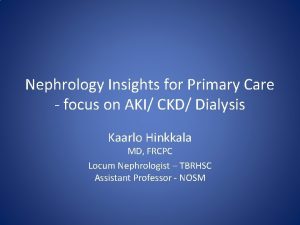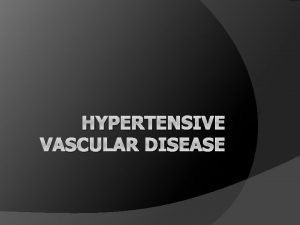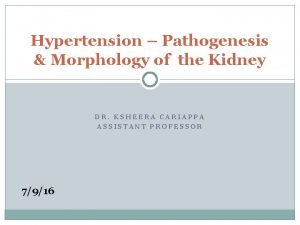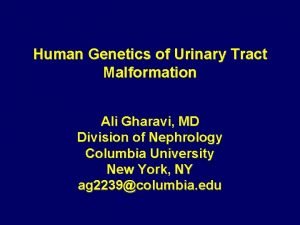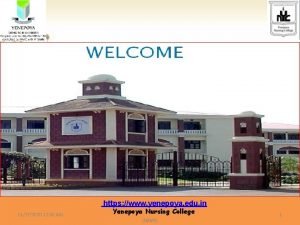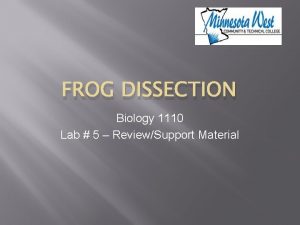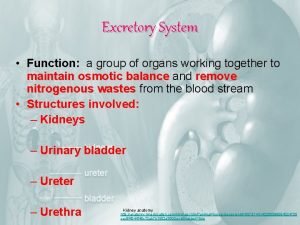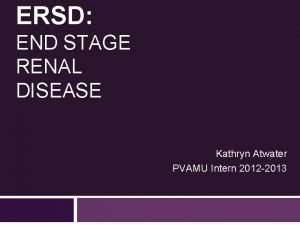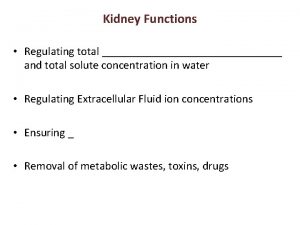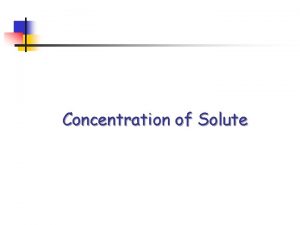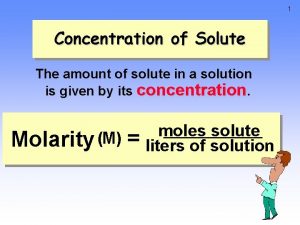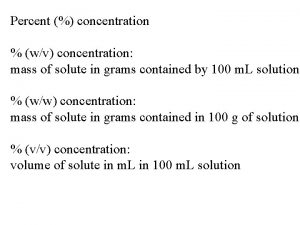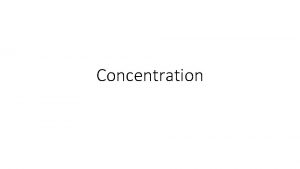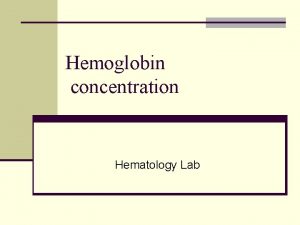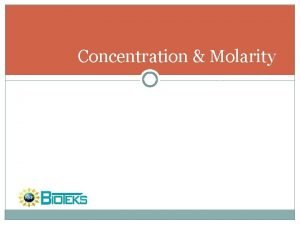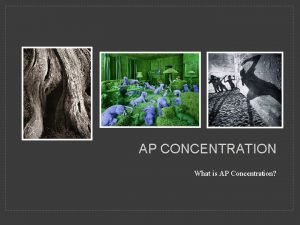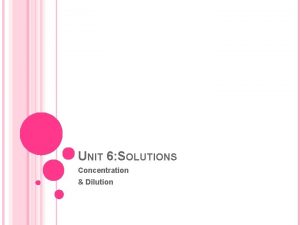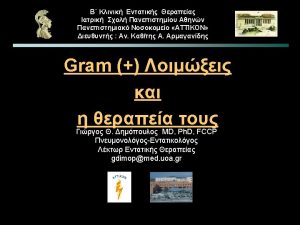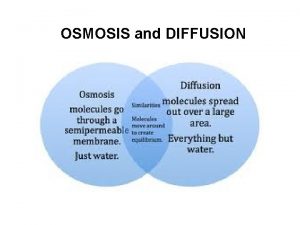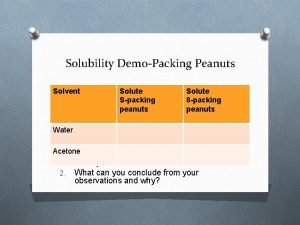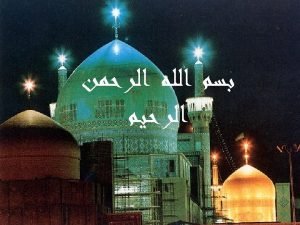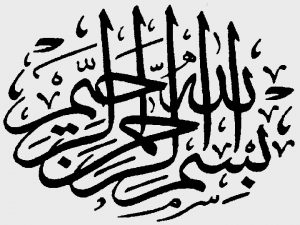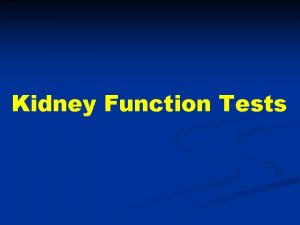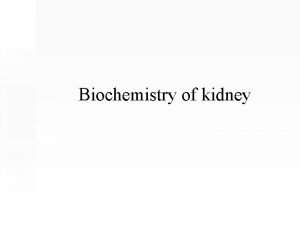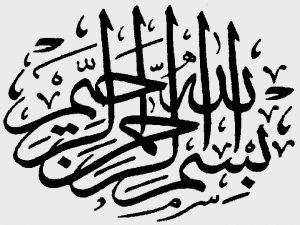Kidney Functions Regulating total and total solute concentration

























































































- Slides: 89

Kidney Functions • Regulating total ________________ and total solute concentration in water • Regulating Extracellular Fluid ion concentrations • Ensuring _ • Removal of metabolic wastes, toxins, drugs

Kidney Functions • Endocrine functions – • regulation of blood pressure – Erythropoietin • regulation of _ • Activation of _ • Gluconeogenesis during prolonged fasting

Urinary System Organs • Kidneys – • – transport urine from kidneys to urinary bladder • Urinary bladder – temporary storage reservoir for urine • ___________ transports urine out of body

Kidney Anatomy • • in the superior lumbar region; – T 12 to L 5 • Right kidney crowded by liver – • Adrenal (_____________) gland atop each kidney • Convex lateral surface, concave medial surface; vertical renal hilum leads to _ – Ureters, renal blood vessels, lymphatics, and nerves enter and exit at hilum

Kidney Anatomy • Layers of surrounding supportive tissue – • Anchoring outer layer of dense fibrous connective tissue – Perirenal fat capsule • Fatty cushion – • Prevents spread of infection to kidney

Internal Anatomy • – Granular-appearing superficial region • Renal medulla – Composed of _ – Pyramids separated by _ • Inward extensions of cortical tissue

Internal Anatomy • – Tip of pyramid; releases urine into minor calyx • – Medullary pyramid and its surrounding cortical tissue; ~ 8/kidney • Renal pelvis –

Internal Anatomy • Minor calyces – • – Collect urine from minor calyces – Empty urine into renal pelvis • Urine flow –

Homeostatic Imbalance • – Infection of renal pelvis and calyces • Pyelonephritis – Infection/inflammation of _ • Normally - successfully treated with _

Blood and Nerve Supply • Kidneys – – adjust its composition • Needs a rich blood supply • Nerve supply via ______________ fibers from renal plexus

Nephrons • Structural and functional units that form urine • 1 million per kidney • Two main parts – –

Renal Corpuscle • Two parts of renal corpuscle – • Capillaries – highly porous – allows filtrate formation – _____________ (Bowman's capsule) • Cup-shaped, hollow structure surrounding glomerulus

Renal Tubule • Three parts – • Proximal closest to renal corpuscle – – • Distal farthest from renal corpuscle

Renal Tubule • Proximal convoluted tubule (PCT) – Cuboidal cells with dense microvilli • – Functions in ___________ and secretion – Confined to _

Renal Tubule • – – Proximal descending limb continuous with proximal tubule – Distal descending limb • descending thin limb – simple squamous epithelium • Thick ascending limb – Cuboidal to columnar cells

Renal Tubule • Distal convoluted tubule (DCT) – Cuboidal cells with very few microvilli – Function more in _ – Confined to _

Collecting Ducts • Receive filtrate _ • Run through ____________ striped appearance • Fuse together to deliver urine through _

Classes of Nephrons • – 85% of nephrons; almost entirely in cortex • Juxtamedullary nephrons – Long nephron loops _ – Ascending limbs have thick and thin segments – Important in production _

Nephron Capillary Beds • Renal tubule associated with two capillary beds – – • Juxtamedullary nephron associated with –

Nephron Capillary Beds • Glomerulus – • Different from other capillary beds – – Afferent arteriole _____________ efferent arteriole • Blood pressure in glomerulus high because – – Arterioles are high-resistance vessels

Nephron Capillary Beds • _____________________ capillaries – Low-pressure, porous capillaries adapted for absorption of water and solutes – Arise from _ – Cling to adjacent renal tubules in cortex –

Nephron Capillary Beds • – Long, thin-walled vessels parallel to ______________________ of juxtamedullary nephrons – Arise from efferent arterioles serving juxtamedullary nephrons • Instead of peritubular capillaries – Function in _

Juxtaglomerular Complex (JGC) • • Involves modified portions of – Distal portion of ascending limb of nephron loop – • Important in regulation of ______________ and blood pressure

Juxtaglomerular Complex (JGC) • Three cell populations – – – extraglomerular mesangial cells • Macula densa – Tall, closely packed cells of ascending limb – _____________; sense Na. Cl content of filtrate

Juxtaglomerular Complex (JGC) • ___________ (juxtaglomerular, or JG cells) – Enlarged, _ – Secretory granules contain enzyme renin – Mechanoreceptors • sense ____________ in afferent arteriole

Juxtaglomerular Complex (JGC) • Extraglomerular mesangial cells – Between _ – Interconnected with _ – May pass signals between macula densa and granular cells

Kidney Physiology: Mechanisms of Urine Formation • Three processes in urine formation and adjustment of blood composition – – –

Kidney Physiology: Mechanisms of Urine Formation • Glomerular filtration – produces ______________ and protein-free filtrate • Tubular reabsorption – Selectively _________________________ in renal tubules and collecting ducts • Tubular secretion – Selectively moves substances from blood to filtrate in renal tubules and collecting ducts

Kidney Physiology: Mechanisms of Urine Formation • Kidneys filter body's entire plasma volume 60 times each day • consume 20 -25% oxygen used by body at rest • produce _ • Filtrate (produced by glomerular filtration) – • Urine – <1% of original filtrate – Contains metabolic wastes and unneeded substances

Glomerular Filtration • • No metabolic energy required • _____________ pressure forces fluids and solutes through filtration membrane • No reabsorption into capillaries of glomerulus

The Filtration Membrane • _________________membrane between blood and interior of glomerular capsule – Water, solutes smaller than plasma proteins pass; _ • Three layers – Fenestrated endothelium of glomerular capillaries – Basement membrane (fused basal laminae of two other layers) – Foot processes of _________________ with filtration slits

Pressures That Affect Filtration • Outward pressures promote filtrate formation – ______________________ pressure in glomerular capillaries • Glomerular blood pressure • Chief force pushing water, solutes out of blood • Quite high – 55 mm Hg – Because ______________________________ with diameter smaller than afferent arteriole

Pressures That Affect Filtration • Inward forces inhibiting filtrate formation – Hydrostatic pressure in _ • Pressure of filtrate in capsule – 15 mm Hg – Colloid osmotic pressure in _ • "Pull" of proteins in blood – 30 mm Hg • Sum of forces _ – 55 mm Hg forcing out; 45 mm Hg opposing = net outward force of 10 mm Hg

Net Filtration Pressure (NFP) • Pressure responsible for filtrate formation (10 mm Hg) • ____________________ determining glomerular filtration rate (GFR)

Glomerular Filtration Rate (GFR) • Volume of filtrate formed per minute by both kidneys (normal = 120– 125 ml/min) • GFR directly proportional to – • primary pressure is hydrostatic pressure in glomerulus – Total ______________________ available for filtration • glomerular mesangial cells control by contracting – Filtration membrane _ • much more permeable than other capillaries

Regulation of Glomerular Filtration • ________________ GFR allows kidneys to make filtrate and maintain extracellular homeostasis – Goal of _ • maintain GFR in kidney • GFR affects systemic blood pressure – increased GFR ________________ ___________blood pressure, and vice versa – Goal of extrinsic controls • maintain _

Regulation of Glomerular Filtration • Intrinsic controls – renal _ • Act locally within kidney to maintain GFR • Extrinsic controls – ________________________ mechanisms that maintain blood pressure; can negatively affect kidney function – Take precedence over intrinsic controls if systemic BP < 80 or > 180 mm Hg

Regulation of Glomerular Filtration • Controlled via glomerular hydrostatic pressure – If rises _____________ GFR rises

Intrinsic Controls • Maintains nearly constant GFR when arterial blood pressure is in range of 80– 180 mm Hg – Autoregulation _

Intrinsic Controls: Myogenic Mechanism • Smooth muscle contracts when stretched • BP _________________ constriction of afferent arterioles _______________________ – Protects glomeruli from _ • BP dilation of afferent arterioles • Both help maintain normal GFR despite normal fluctuations in blood pressure

Extrinsic Controls: Sympathetic Nervous System • Under normal conditions at _ – Renal autoregulation mechanisms prevail

Extrinsic Controls: Sympathetic Nervous System • If extracellular fluid _____________ (blood pressure low) – Norepinephrine released by sympathetic nervous system; epinephrine released by adrenal medulla • Systemic __________________ increased blood pressure • Constriction of afferent arterioles _________ increased blood volume and pressure

Extrinsic Controls: Renin-Angiotensin. Aldosterone Mechanism • Three pathways to renin release by granular cells – _____________stimulation of granular cells by sympathetic nervous system – Stimulation by activated ___________________ when filtrate Na. Cl concentration low – Reduced stretch of granular cells

Extrinsic Controls: Other Factors Affecting GFR • Kidneys release chemicals; some act as ________________ that affect renal arterioles – – Prostaglandin E 2 – Intrinsic angiotensin II • reinforces effects of hormonal angiotensin II

Tubular Reabsorption • Most of tubular contents _ • Selective transepithelial process – – Water and ion reabsorption hormonally regulated and adjusted • Includes active and passive tubular reabsorption • Two routes –

Tubular Reabsorption • Transcellular route – Passes _____ cells from lumen – Passes _____ the cytoplasm – Passes _____ cell and into blood • Paracellular route –

Tubular Reabsorption of Sodium • _____ - most abundant __________ in filtrate

Passive Tubular Reabsorption of Water • Movement of Na+ and other solutes creates osmotic gradient for water • Water reabsorbed by osmosis, aided by water-filled pores called _ – Aquaporins always present in PCT • ______________________ water reabsorption – Aquaporins inserted in collecting ducts _ • ______________________ water reabsorption

Passive Tubular Reabsorption of Solutes • Solute concentration in filtrate increases as water reabsorbed concentration gradients for solutes • ____________________, some ions and urea, follow water into _____________________ down concentration gradients – Lipid-soluble drugs, environmental pollutants difficult to excrete

Transport Maximum • Transcellular transport systems – – limited – Transport maximum for almost every reabsorbed substance; • reflects _______________________ in renal tubules available – When carriers saturated, excess excreted in urine • hyperglycemia high blood glucose levels exceed transport maximum

Reabsorptive Capabilities of Renal Tubules and Collecting Ducts • Proximal Convoluted Tubules – Site of most reabsorption • ______________________ , e. g. , glucose and amino acids • 65% of Na+ and water • Many ions • ~ All uric acid; ½ urea (_________________________)

Reabsorptive Capabilities of Renal Tubules and Collecting Ducts • – Descending limb • H 2 O can leave; – Ascending limb • ____________ cannot leave; solutes can

Reabsorptive Capabilities of Renal Tubules and Collecting Ducts • Distal Collecting Tubule and collecting duct – • Antidiuretic hormone (______) – • Aldosterone – • Atrial natriuretic peptide (ANP) – • PTH – Ca 2+

Reabsorptive Capabilities of Renal Tubules and Collecting Ducts • Antidiuretic hormone (ADH) – Released by _ – Causes principal cells of collecting ducts to insert aquaporins in apical membranes • • As ADH levels increase

Reabsorptive Capabilities of Renal Tubules and Collecting Ducts • – Targets _ – Promotes synthesis of Na+ and K+ channels • Na+ reabsorption and K+ secretion • water follows Na+ – Functions • increase blood pressure; decrease K+ levels

Reabsorptive Capabilities of Renal Tubules and Collecting Ducts • Atrial natriuretic peptide – + • decreased blood volume and blood pressure – Released by ____________________ if blood volume or pressure elevated • Parathyroid hormone acts on DCT –

Tubular Secretion • ______________; almost all in _ – Selected substances – K+, H+, NH 4+, creatinine, organic acids and bases move from peritubular capillaries through tubule cells into filtrate – Substances synthesized in tubule cells also secreted – e. g. , HCO 3

Tubular Secretion • Disposes of substances (e. g. , drugs) _ • Eliminates undesirable substances passively reabsorbed (e. g. , urea and uric acid) • Rids body of ______________ (aldosterone effect) • Controls blood p. H by altering amounts of ______ or ______ in urine

Countercurrent Mechanism • Role of countercurrent mechanisms – Establish and maintain ______________________ from renal cortex through medulla – Allow kidneys to _

Formation of Dilute or Concentrated Urine • Osmotic gradient used to _ – Overhydration – Dehydration • ADH released • Severe dehydration – 99% water reabsorbed

Diuretics • Chemicals that enhance urinary output – ADH inhibitors • – _____________________ inhibitors • caffeine, drugs for hypertension or edema – Loop diuretics inhibit medullary gradient formation – Osmotic diuretics • • high glucose of diabetic patient

Clinical Evaluation of Kidney Function • Urine examined for signs of disease • Assessing ________________ requires both ______________ and ____________ examination

Renal Clearance • Volume of plasma kidneys clear of particular substance in given time • ____________________ used to determine GFR – To detect _ – To follow _

Renal Clearance • Inulin (a ______________________) is standard used – Freely filtered – neither reabsorbed nor secreted by kidneys – its renal clearance = GFR = 125 ml/min • Means that in one minute, the kidney has cleared all of the inulin present in 125 ml of plasma • If clearance value is _ – substance _ • If clearance value is _ – substance completely reabsorbed – Or not filtered • If clearance value is the same as inulin – no net reabsorption or secretion • If clearance is _ – substance secreted • Allows for adjustment of drug dosages. If the drugs break down and are eliminated in the urine, a larger or more frequent dosage may be needed.

Homeostatic Imbalance • – GFR is less than 60 ml/min for 3 months – Filtrate formation ____________________ and wastes build up in the blood • diabetes mellitus; hypertension • Renal failure – GFR less than 15 ml/min – Causes __________________ syndrome • • Wastes not removed • Symptoms: – fatigue, anorexia, nausea, mental changes, muscle cramps – Treated with hemodialysis or transplant

Physical Characteristics of Urine • Color and transparency – • Cloudy may indicate _ – Pale to deep yellow from _ • Pigment from hemoglobin breakdown; more concentrated urine deeper color – Abnormal color (pink, brown, smoky) • Food ingestion, bile pigments, blood, drugs

Physical Characteristics of Urine • Odor – Slightly aromatic when fresh – Develops _________________ upon standing • As bacteria metabolize solutes – May be altered by some drugs and vegetables or diseases • Smells ______________ with uncontrolled diabetes mellitis

Physical Characteristics of Urine • – Slightly acidic (~_________, with range of 4. 5 to 8. 0) • Acidic diet (protein, whole wheat) _ • Alkaline diet (vegetarian), prolonged vomiting, or urinary tract infections _ • Specific gravity – 1. 001 to 1. 035; dependent on solute concentration – Is a comparison of the mass of the urine to an _

Chemical Composition of Urine • 95% water and 5% solutes • Nitrogenous wastes – • from amino acid breakdown • largest solute component – • from nucleic acid metabolism – • metabolite of creatine phosphate

Chemical Composition of Urine • Other normal solutes – Na+, K+, PO 43–, and SO 42–, Ca 2+, Mg 2+ and HCO 3– • Abnormally high concentrations or abnormal components may _ – blood proteins – –

Urine transport, Storage, and Elimination: Ureters • Convey urine from _ – Begin at L 2 as continuation of renal pelvis • • Enter base of bladder through posterior wall – As bladder pressure increases, distal ends of ureters close, preventing backflow of urine

Ureters • Three layers of ureter wall from inside out – Mucosa • – Muscularis • smooth muscle _ • Contracts in response to _ • Propels urine into bladder – Adventitia • outer fibrous connective tissue

Homeostatic Imbalance • Renal calculi – kidney ________________in _ – Crystallized calcium, magnesium, or uric acid salts • Large stones block ureter pressure & pain • May be due to – – chronic bacterial infection urine retention p. H of urine • Treatment - ________________ lithotripsy – noninvasive; shock waves shatter stones

Urinary Bladder • Muscular sac for _ • Retroperitoneal, on pelvic floor posterior to pubic symphysis – Males • – Females • anterior to _

Urinary Bladder • Openings for _ • – Smooth triangular area outlined by openings for ureters and urethra – ____________________ tend to persist in this region

Urinary Bladder • Layers of bladder wall – • transitional epithelial mucosa – Thick ______________ muscle • three layers of smooth muscle – Fibrous adventitia

Urinary Bladder • Collapses when empty; _ • Expands and rises superiorly during filling without significant rise in internal pressure • Full bladder 12 cm long; holds about 500 ml – – Can ________________ if overdistended

Urethra • ___________________ draining urinary bladder – Lining epithelium • Mostly pseudostratified columnar epithelium, except – Transitional epithelium near bladder –

Urethra • Sphincters – • Involuntary (smooth muscle) at bladder-urethra junction • – • Voluntary (skeletal) muscle surrounding urethra as it passes through pelvic floor

Urethra • Female urethra (3– 4 cm) – Tightly bound to _ – • Anterior to vaginal opening; posterior to clitoris

Urethra • Male urethra carries semen and urine – Three named regions • – within prostate gland • Intermediate part of the urethra (membranous urethra) – passes through urogenital diaphragm from prostate to beginning of penis • – passes through penis; opens via external urethral orifice

Micturition • Urination or voiding • Three simultaneous events must occur – ________________________ muscle by Autonomic Nervous System – Opening of _____________________ by somatic nervous system

Micturition • Reflexive urination (________________) – Distension of bladder activates _ – Excitation of parasympathetic neurons in reflex center in sacral region of spinal cord – Contraction of _ – Contraction (opening) of _ – Inhibition of somatic pathways to external sphincter, allowing its relaxation (opening)

Micturition • Pontine control centers mature between ages 2 and 3 – Pontine _________________ inhibits micturition • Inhibits parasympathetic pathways • Excites sympathetic and somatic efferent pathways – Pontine micturition center _ • Excites parasympathetic pathways • Inhibits sympathetic and somatic efferent pathways

Homeostatic Imbalance • ___________________ usually from weakened pelvic muscles – Stress incontinence • Increased ________________________ forces urine through external sphincter – Overflow incontinence • Urine dribbles when _

Homeostatic Imbalance • Urinary retention – Bladder _ – Common after _ – – Treatment • catheterization

Homeostatic Imbalance • Three common congenital abnormalities • – Two kidneys fuse across midline single U-shaped kidney; usually _ • Hypospadias – – Corrected surgically at ~ 12 months

Homeostatic Imbalance • Polycystic kidney disease – Many _____________ interfere with function • Autosomal dominant form – • Autosomal recessive – more severe – Cause unknown but involves defect in signaling proteins

Developmental Aspects • Most elderly people have abnormal kidneys histologically – – nephrons _ – tubule cells less efficient – GFR ½ that of young adult by age 80 • atherosclerosis of _ • Bladder shrinks; loss of bladder tone – • Needing to get up during night/sleep to urinate – incontinence
 Zucchini cores placed in sucrose solutions at 27
Zucchini cores placed in sucrose solutions at 27 Solute concentration
Solute concentration Concentration gradient
Concentration gradient Movement of high concentration to low concentration
Movement of high concentration to low concentration Chapter 6 understanding the management process
Chapter 6 understanding the management process Regulating body temperature
Regulating body temperature Regulating body temperature
Regulating body temperature Fasting plasma glucose concentration
Fasting plasma glucose concentration Regulating body temperature
Regulating body temperature 10-3 regulating the cell cycle
10-3 regulating the cell cycle Goole valve
Goole valve Factors affecting stroke volume
Factors affecting stroke volume 10-3 regulating the cell cycle
10-3 regulating the cell cycle Functions of kidney
Functions of kidney Physiology of kidney
Physiology of kidney 7 functions of the kidney
7 functions of the kidney Define solute and solvent
Define solute and solvent Solute vs solvent
Solute vs solvent Saturated vs unsaturated solution
Saturated vs unsaturated solution What is solvent in science grade 7
What is solvent in science grade 7 Solute and solvent
Solute and solvent Solute of rubbing alcohol
Solute of rubbing alcohol Homogeneous mixture of a solute in a solvent
Homogeneous mixture of a solute in a solvent Sweet tea solute and solvent
Sweet tea solute and solvent Chapter 1 matter and change worksheet answers
Chapter 1 matter and change worksheet answers Examples of solute and solvent combinations
Examples of solute and solvent combinations Lemonade solute and solvent
Lemonade solute and solvent Vinegar solute or solvent
Vinegar solute or solvent Diaphragm and kidney
Diaphragm and kidney Medulla kidney
Medulla kidney Nigel gibbons
Nigel gibbons Pictures of white particles in urine
Pictures of white particles in urine Solute potential equation
Solute potential equation Osmosis equation
Osmosis equation Water potential meaning
Water potential meaning Solute potential definition biology
Solute potential definition biology Factors affecting rate of diffusion
Factors affecting rate of diffusion Solute vs solvent
Solute vs solvent Polar mixture
Polar mixture Solute vs solvent
Solute vs solvent What operation yields the number of moles of solute
What operation yields the number of moles of solute Solute of rubbing alcohol
Solute of rubbing alcohol Solute vs solvent
Solute vs solvent How to calculate percent concentration
How to calculate percent concentration What is vapor pressure lowering
What is vapor pressure lowering Why freezing point decreases on adding solute
Why freezing point decreases on adding solute How to find ionization constant for water potential
How to find ionization constant for water potential The vapor pressure of pure water at 110 c is 1070 torr
The vapor pressure of pure water at 110 c is 1070 torr What is water potential
What is water potential Contoh solute
Contoh solute What does act stand for
What does act stand for A measure of the amount of solute dissolved in a solvent
A measure of the amount of solute dissolved in a solvent Which phrase describes the molarity of a solution
Which phrase describes the molarity of a solution Interstitial fluid vs extracellular fluid
Interstitial fluid vs extracellular fluid Different type de soluté
Different type de soluté Contoh solvent
Contoh solvent Transport protein
Transport protein Polar solute
Polar solute Effect of temperature on solubility
Effect of temperature on solubility He took his seat quietly
He took his seat quietly How to evaluate function
How to evaluate function Evaluating functions and operations on functions
Evaluating functions and operations on functions Activo promedio
Activo promedio Total revenues minus total costs equals
Total revenues minus total costs equals Total revenues minus total costs equals
Total revenues minus total costs equals Total revenues minus total costs equals
Total revenues minus total costs equals Total revenue minus total expenses
Total revenue minus total expenses Panchajani
Panchajani Juxtaglomerular apparatus
Juxtaglomerular apparatus Pearson
Pearson Kidney infection
Kidney infection Kidney regions
Kidney regions Internal anatomy of the kidney
Internal anatomy of the kidney Papillary duct of bellini
Papillary duct of bellini Figure 15-4 is a diagram of a nephron
Figure 15-4 is a diagram of a nephron Tubule
Tubule Meetslk
Meetslk Kidney pathology
Kidney pathology Myogenic mechanism kidney
Myogenic mechanism kidney Histological structure of kidney
Histological structure of kidney Coverings of kidney
Coverings of kidney Arenesp
Arenesp Flea bitten kidney seen in
Flea bitten kidney seen in Hyperplastic arteriolitis
Hyperplastic arteriolitis Hypoplasia
Hypoplasia Uric acid kidney stone
Uric acid kidney stone What is a renal lobule
What is a renal lobule Organ found within the mesentery that stores blood frog
Organ found within the mesentery that stores blood frog Function of excretory system
Function of excretory system Nephrology near atwater
Nephrology near atwater
